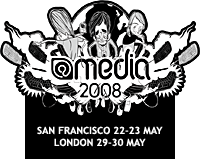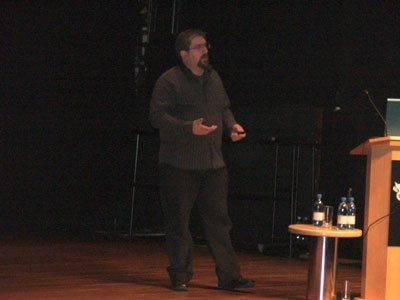@Media 2008 London. Report. Part two

Part one .
The second day of the conference began with the
He urged web developers not to neglect their work, even if they are convinced that the project they are doing is not important and will not develop. The web, as you know, is a dynamic and constantly expanding environment; according to this, any project, even the smallest, can “shoot” and it will have to be urgently expanded, improved and developed. Accordingly, it is not worth saving on documentation, commenting on your own code, it is worth remembering the possibilities of reusing interface elements and the possibilities for expansion.
And in the end, Nate reminded those present that the idea of them was formed by their work. In general, and in general, the report turned out to be correct, except that it was hard for some to perceive it in the morning ...
I liked the phrase Nate - We are responsible for the "View source"!
Following Nate, Jonathan Snook , a well-known Canadian freelance web developer, took the stage. His report, Building on the Shoulders of Giants, was based on the fact that many web developers like to reinvent the wheel every time. In and of itself, this is not so bad, especially at the beginning of a professional career, as it helps to understand the basics and acquire their own work. But such an approach in a competitive environment is a serious disadvantage, since having an idea and spending a great deal of time developing it from scratch, you risk coming to the market far from the first; everyone knows that the same ideas come to different people in the head at the same time and the one who realizes his plans faster than the others wins.
')

Jonathan urged to use the experience of industry giants for their needs and implement ideas quickly, with minimal resources and time. The main idea is to use the open practices, API, libraries and knowledge base to implement the primary version of your project, “stake out the territory” and then quietly continue development, at the same time getting a free bug-track from beta testers and focus groups. In the report, Jonathan gave an example of implementing a simple application based on the Twitter API and Jquery, in which tweets were placed on the page in the form of a timeline. According to him, he wrote this application a few hours in the evening before the conference. A further example, already successful in North America, cited at the conference, MyMileMarker . By the way, remake lovers can try to implement a similar service in RuNet;)
The curious thing that Jonathan talked about is that when using open APIs, the developer acts as an intermediary between the service and the users and in case of a service / API failure, such as Twitter, users of the application you developed will blame you and not Twitter. Therefore, such moments need to think about in advance and try to prevent.
The next report was a report on Javascript libraries and led by none other than John Resig , the creator and lead developer of Jquery . The title of the report “The Why and Which of JavaScript Libraries” already created a problem since John, as a person personally interested, could not give an objective explanation of which library is better and should be used. Of course, he himself understood this and therefore posted a report on the comparison of libraries on various characteristics.
I started from afar, with general information, I went through usage statistics (most developers use Jquery (32%) and Prototype (32%), the rest is shared by YUI (20%), Dojo and their ilk), ran through the characteristics. The report turned out to be a review, almost without specifics, but in my opinion only because of the total lack of time. In the end, Jquery and Prototype are the leaders, with no surprises.

At the end of the report again there was no time left for questions and I added my question “How do you feel about the idea of adding popular Javascript libraries to browsers as components / plugins?” In the Questions and Answers section, which was scheduled for the end of the day. Looking ahead, I must say that unfortunately we did not have time to get to this question.
After a lunch break, Steve Faulkner of Paciello Group, the director of The Web Accessibility Tools Consortium (WAT-C), gave a talk on “WAI (Web Accessibility Initiative) - ARIA (Accessible Rich Internet Applications) - It's Easy. It was about the availability of web applications and services for people with limited visual capabilities. In the role of the experimental rabbit again, the long-suffering Twitter appeared. Using the example of using additional attributes in markup, Steve wanted to show the relative ease of creating documents that will be more correctly handled by Screen Readers and will be more accessible to them. But it was not so simple.
The examples that Steve cited only worked on synthetic tests, the code of which Steve did not show. In addition, the documents in which attributes are added from WAI-ARIA become invalid, since WAI-ARIA has not yet become a recommendation of the W3C. Not without curiosity. During one of the demonstrations, Screen Reader JAWS, connected to the general speakers, decided to give an independent speech at a speed of 120 words per minute. An agitated Steve could not calm him down for a long time and the audience giggled for a rather long time, sometimes turning into a squeezed whinny :)
Notwithstanding the foregoing, the topic is very serious and deserves the closest attention. Unfortunately, developers still do not have enough tools (yes, there is almost no at all) in order to make life easier for people with physical disabilities, which is depressing.
The final report of the conference I went to was “Exploring the Server Side: Rails & Django”, which were led by James Adam and Simon Willison . The purpose of the report was to introduce Front-End server technologies to developers for common development and to interest potential users. The reports turned out to be easy, full of examples and live code writing during the report. In my case, the reports have reached the goal, since I, who do not know Ruby or Django, became interested and will try :)
Here it is quite difficult for me to talk about specifics, but in my humble understanding, Ruby on Rails was positioned as a framework in which it is easy to build applications and work with databases, and Django as a framework in which to build content-oriented sites (if anything, beat).
Actually, the reports ended and the Questions and Answers section began. On the section for a long time it was decided how to correctly call Front-End Web Developer or Front-End Engeneer. In the end, it was decided that it was not the title of the case, but the importance of this profession in the process of web development. My question about the Javascript library was never reached.
General impressions :
The first day of the conference let us down a little, but this is a subjective opinion. The second day corrected the situation, but there was a lack of specifics and all the time there was a feeling like “well, now, now it will be, now it will be ignited,” but somehow it was not very justified.
I was very pleased with the opportunity to communicate with other web developers, the exchange of views and experience, the feeling, if not of brotherhood, then of the guild :)
In general, @Media is an outstanding event, the conference attracts a huge number of web developers from around the world who create an excellent atmosphere for communication and knowledge sharing. It seems to me that now the organizers are on the verge of deciding what the conference should look like in the future. I am sure that they will draw the right conclusions and I will try to go there and next time.
Source: https://habr.com/ru/post/26872/
All Articles